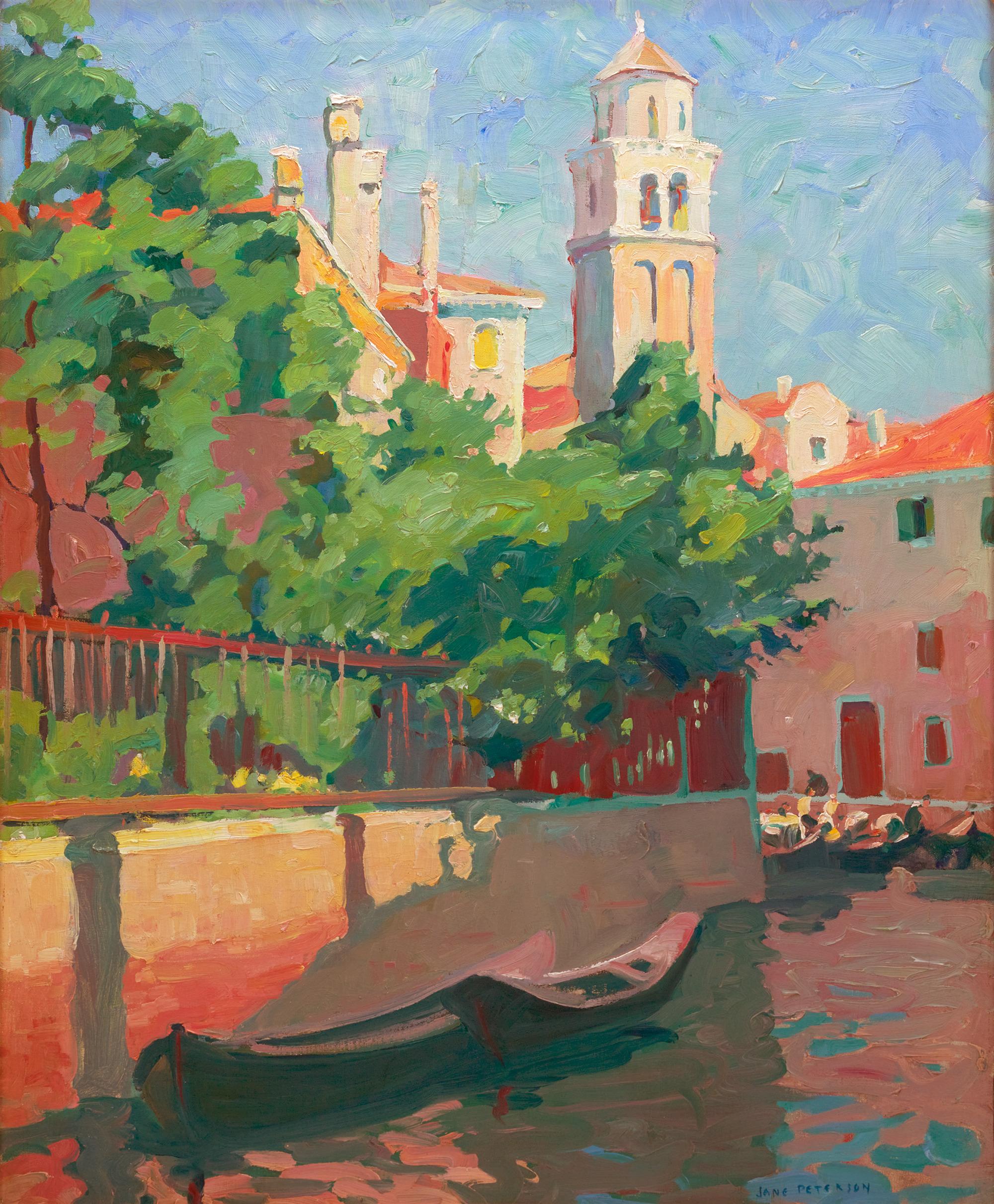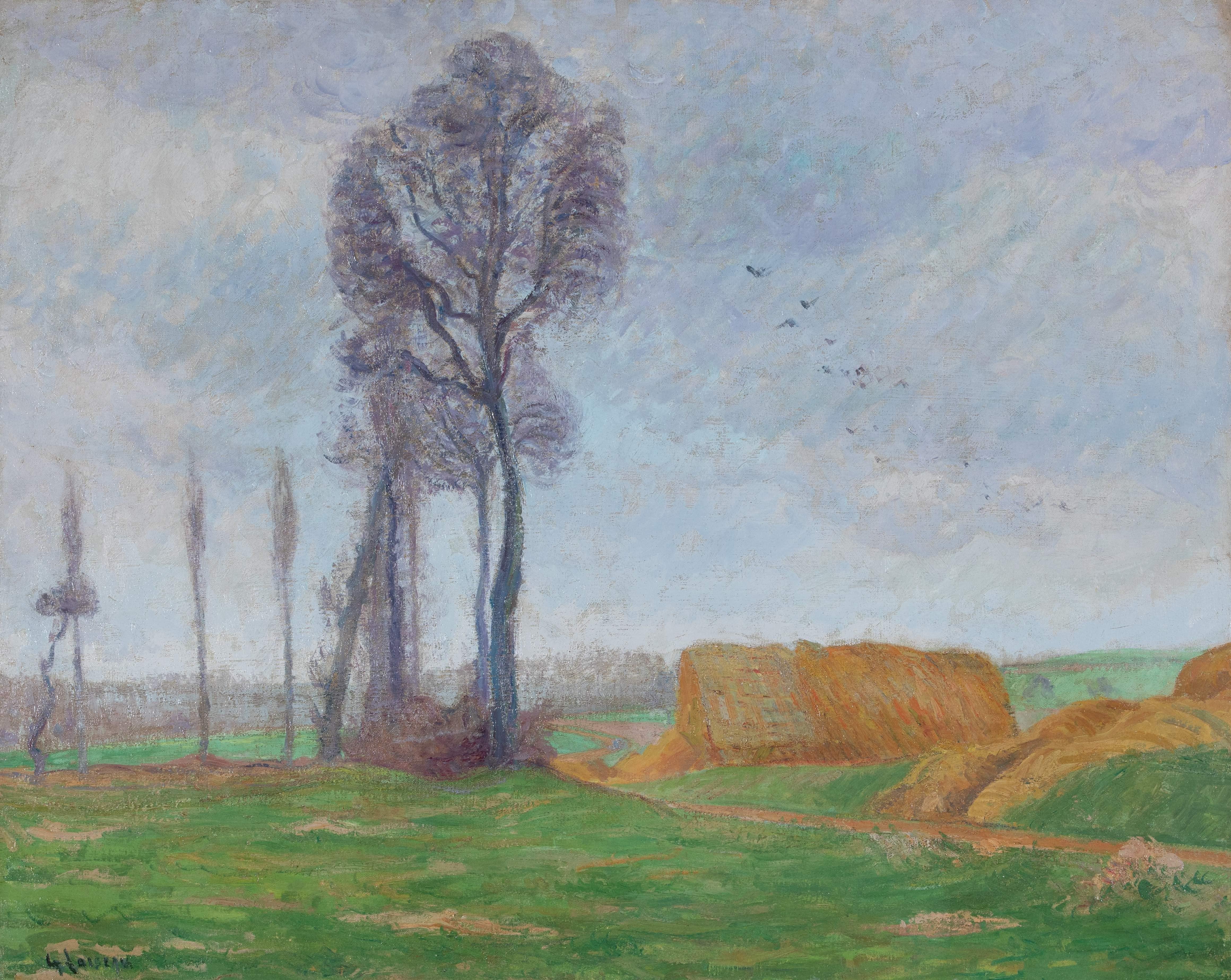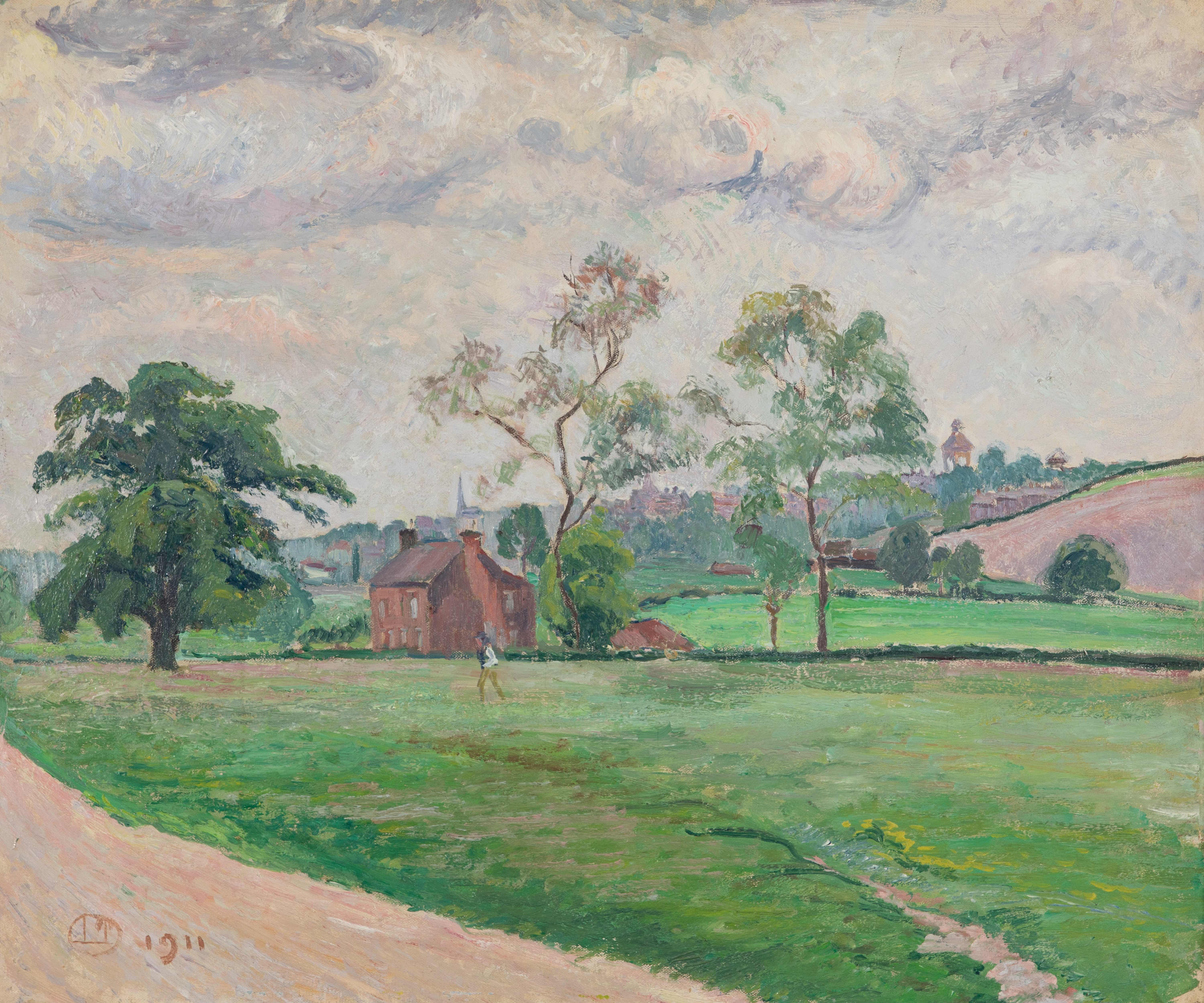Items Similar to Les Cypres, French Post-Impressionist Landscape Painting, Signed
Want more images or videos?
Request additional images or videos from the seller
1 of 6
Robert DeborneLes Cypres, French Post-Impressionist Landscape Painting, Signed
About the Item
Oil on canvas, signed bottom right
Image size: 29 x 40 inches (74 x 101 cm)
Contemporary style handmade frame
Provenance
Artist's Estate
Robert Deborne
Robert Deborne was born in 1870 in Viviers, a small cathedral town in the South of France.
Little is known of the finer details of Deborne’s life and he remains rather an enigma. He was the son of a rich farmer, which gave him the opportunity to concentrate on his painting without financial pressures. Indeed, he was so dedicated that he abandoned his family just before the First World War, enabling him to focus completely on his work. Despite his prolificacy, he decided never to hold a solo exhibition nor had any connection with an art dealer to sell his works, although he exhibited often at the Salon d’Automne in Paris (becoming a member in 1923) and the Salon du Sud-Est.
A noted talent in his day, Deborne exhibited with major artists at the Salon du Sud-Est. This salon exhibition was on during the winter, which was perfect for Deborne as he was able to paint all summer, his preferred season. The Salon was a forum for unknown, innovative, emerging artists. His paintings were hung alongside works by Paul Cézanne, Henri Matisse, Paul Gaugin, Georges Rouault, André Derain, Albert Marquet, Felix Vallotton and Edouard Vullard, to name but a few.
Deborne was exhibiting at the Salon du Sud-Est in 1905, the year when the press coined the then rather disparaging term of ‘Fauves’ (French for ‘wild beasts’) to describe artists using strong, separate, unnatural colours in a representational manner, moving away from the realism of impressionism. The phrase stuck and the new movement of Fauvism was recognised, of which Deborne was certainly a part and influenced by.
Deborne had a close friendship with Paul Signac with whom he exhibited on several occasions at the Salon de Sud-Est. Signac spent some time in Viviers with Deborne, and the two are known to have been together on the banks of the Rhône, sketching and painting.
He mostly painted scenes of Viviers, his home town on the Rhône and its environs. He also featured Nebbio in Corsica in many of his paintings. His works are very much centered on these places that he loved, and his depictions of the Rhône, its banks and the hills beside it are poetically marked by variations in time, weather and season. He was particularly fond of painting at dawn and dusk.
Robert Deborne returned to the same landscapes again and again, portraying them from different perspectives and in changing light. This was a deliberate choice – he wanted to share the beauty of these inspiring places that were immediately before him. Vivarais to Deborne was what the Montagne Sainte-Victoire was for Cézanne or the banks of the Creuse were for Guillaumin. These landscapes were his life, and every brushstroke illuminates the beauty of these places for others to experience.
- Creator:Robert Deborne (1870 - 1944, French)
- Dimensions:Height: 40 in (101.6 cm)Width: 27 in (68.58 cm)
- More Editions & Sizes:1 of 1Price: $38,971
- Medium:
- Movement & Style:
- Period:
- Condition:
- Gallery Location:London, GB
- Reference Number:1stDibs: LU52414058002
About the Seller
5.0
Vetted Seller
These experienced sellers undergo a comprehensive evaluation by our team of in-house experts.
Established in 2007
1stDibs seller since 2014
64 sales on 1stDibs
Typical response time: 2 hours
- ShippingRetrieving quote...Ships From: London, United Kingdom
- Return PolicyA return for this item may be initiated within 14 days of delivery.
More From This SellerView All
- Paysage du Viviers, French Post-Impressionist Oil PaintingLocated in London, GBRobert Deborne French 1870 - 1944 Viviers Oil on canvas, signed lower right Image size: 25 3/4 x 20 1/2 inches Gilt frame Robert Deborne (1870-1944) ...Category
Late 19th Century Post-Impressionist Landscape Paintings
MaterialsCanvas, Oil
- Paysage du Vivarais avec une Ferme, French Post-Impressionist, Signed PaintingLocated in London, GBOil on canvas, signed bottom right Image size: 26 1/4 x 19 3/4 inches (41.5 x 50 cm) Hand made gilt frame Provenance Artist's Estate This work is sold with a certificate of authe...Category
Early 20th Century Post-Impressionist Landscape Paintings
MaterialsOil, Canvas
- Arbre en Fleurs, Oil Landscape, French Post-ImpressionistLocated in London, GBOil on board, mounted on panel, signed lower right Image size: 19 x 23 (48 x 58 cm) Contemporary style handmade frame £10,000 Provenance Artists Estate The Artist Robert Deborne...Category
Early 20th Century Post-Impressionist Landscape Paintings
MaterialsOil, Board
- The Heat of SummerLocated in London, GBOil on board, signed on verso Image size: 31 1/2 x 25 inches (80 x 64 cm) Framed This is a wonderful work of Pointillism, a technique of painting where small, distinct dots of colour are applied in patterns to form an image. This techniques relies on the ability of the eye and mind of the viewer to blend the colour spots into a fuller range of tones. The practice of Pointillism lies in sharp contrast to the traditional methods of blending pigments on a palette. Georges Seurat and Paul Signac developed the technique in 1886, branching from Impressionism. The term 'Pointillism' was coined by art critics in the late 1880s to ridicule the works of these artists, but is now used without its earlier pejorative connotations. The Artist Kenneth Walch Born Wimbledon 1927. After school he moved to Australia in the early 1950’s and won a place at the National Gallery Art School in Melbourne where he studied under Murray Griffin until 1953 when he returned to England. He then enrolled at St Martins School of Art where his principal tutor was the Colourist, Fredrick Gore. Gore introduced him to English post...Category
Mid-20th Century Pointillist Landscape Paintings
MaterialsOil, Board
- Spring in Dorset, 20th Century English Oil Landscape, Female ArtistLocated in London, GBOil on board Image size: 12 1/2 x 15 1/2 inches (31.75 x 40 cm) Contemporary style handmade frame Exhibitions 1952 Royal Academy of Arts Exhibition, Gallery no. VII, no.429. This forest scene invites the viewer into a multi-sensory event where the cool, damp shadows of the foliage can almost be felt and the rich bouquet of the forest floor recalled. Here, Sherlock has chosen a somewhat unusual angle and composition, dissecting each truck and tree form so that only a part can be seen. Furthermore, as we look into the depths of this space it becomes clear that we are stood gazing down into a valley that is in the distance, behind this wooded area. Indeed, instead of giving us an uninterrupted view of this vista, as perhaps would be expected, this view is deliberately blocked and our focus is directed instead towards the organic forms in the foreground. The Artist Marjorie Sherlock was born at Fir Tree Cottage, George Lane, Wanstead, Essex, on 3 February 1891, the elder child of the civil engineer, Henry Sherlock, and his wife, Alice (née Platts), who was born in Benares, India. By 1901, the family was living at ‘The Limes’, 121 Mill Road, Cambridge, and Marjorie received an education locally. In 1918, she entered into marriage with her cousin, Major Wilfrid Barrett, though this proved unsuccessful and they later divorced (he remarrying in 1941). She then continued to live at the family home until the Second World War. During the First World War, Marjorie Sherlock studied at Westminster Technical Institute under the Camden Town School painters, Walter Sickert and Harold Gilman. She exhibited at the Royal Academy of Arts from 1917, when she showed a powerful view of the interior of Liverpool Street Station (Government Art Collection) (to which the current etching [202] relates). In time, she would exhibit at the International Society, the New English Art Club, the Royal Society of British Artists, the Society of 207 Graphic Art and the Women’s International Art Club (becoming a member of the last two). She also showed work internationally. Developing as a printmaker as well as a painter, Sherlock studied etching under Malcolm Osborne at the Royal College of Art in 1925. She published her etchings in four series, the titles of which indicate her love of travel: ‘English Etchings, ‘Egyptian Etchings’ (both 1925), ‘German Etchings’ (1929) and ‘Indian Etchings’ (1932). During this period, she also visited the united States. More admiring of Continental painters than British ones, she furthered her studies, in 1938, by working in Paris under André L’Hôte and André Dunoyer de Segonzac. During the Second World War, Sherlock moved to East Devon and settled at Oxenways, a Victorian hunting lodge...Category
1950s Modern Landscape Paintings
MaterialsOil, Canvas
- Notting Hill Gate Station from the Road, 20th Century Oil PaintingBy Edward McKnight KaufferLocated in London, GBOil on canvas board, signed lower left 'McKnight' Image size: 19 ½ x 14 ½ inches (49.5 x 37 cm) Contemporary frame Looking from the bridge we peer down the Notting Hill Gate Train S...Category
Early 20th Century Modern Landscape Paintings
MaterialsOil, Canvas
You May Also Like
- Gondolas, Venetian Canal By Jane PetersonBy Jane PetersonLocated in New Orleans, LAJane Peterson 1876–1965 American Gondolas, Venetian Canal Signed “Jane Peterson” (lower right) Oil on canvas This remarkable painting, Gondolas, Venetian Canal, by the esteemed A...Category
20th Century Post-Impressionist Landscape Paintings
MaterialsCanvas, Oil
- The Garden Near Cailhau By Achille LaugéBy Achille LaugéLocated in New Orleans, LAAchille Laugé 1861-1944 French The Garden Near Cailhau Signed "A. Laugé 96" (lower left) Oil on canvas “Laugé’s art is one of great sensitivity and controlled reason; he is a mas...Category
19th Century Post-Impressionist Landscape Paintings
MaterialsCanvas, Oil
- Bords du Loing by Alfred Sisley - Oil, landscape paintingBy Alfred SisleyLocated in London, GB*THIS PRICE INCLUDES 5% IMPORT DUTY APPLICABLE IF THE WORK REMAINS IN THE UK ONLY. Bords du Loing by Alfred Sisley (1839-1899) Oil on canvas 46.1 x 55.7 cm (18¹/₈ x 21⁷/₈ inches) S...Category
1890s Post-Impressionist Landscape Paintings
MaterialsCanvas, Oil
- Paysage de neige by Gustave Loiseau - Landscape paintingBy Gustave LoiseauLocated in London, GB*This price excludes 5% import duty applicable if the work remains in the UK. Paysage de neige by Gustave Loiseau (1865-1935) Oil on canvas 54.5 x 65.5 cm (21 ¹/₂ x 25 ³/₄ inches) Signed and dated lower left, G. Loiseau 1911 Provenance: Galerie Rämi, Zurich Private collection, Switzerland This work is accompanied by a photo-certificate of authenticity issued by Didier Imbert...Category
1910s Post-Impressionist Landscape Paintings
MaterialsCanvas, Oil
- Paysage d'Automne à Nesle la Vallée by Gustave Loiseau - Landscape paintingBy Gustave LoiseauLocated in London, GB*PLEASE NOTE UK BUYERS WILL ONLY PAY 5% VAT ON THIS PURCHASE. Paysage d'Automne à Nesle la Vallée by Gustave Loiseau (1865-1935) Oil on canvas 65 X 81.2 cm (25 ⁵/₈ x 32 inches) Sign...Category
1890s Post-Impressionist Landscape Paintings
MaterialsOil, Canvas
- Stormy Weather, Colchester by Lucien Pissarro - Landscape paintingBy Lucien PissarroLocated in London, GBStormy Weather, Colchester by Lucien Pissarro (1863-1944) Oil on canvas 54.3 x 65.3 cm (21 ³/₈ x 25 ³/₄ inches) Signed with monogram and dated lower left, 1911 Provenance: The Brook...Category
1910s Post-Impressionist Landscape Paintings
MaterialsCanvas, Oil





